
Green initiative – operational: Eastern Caribbean Central Bank
ECCB installed its own solar farm in effort to become carbon-neutral

Central banks are playing a leading role in greening the financial sector, by such means as assessing climate-related risk in the financial sector or estimating the environmental impact of assets. There is another way in which they can affect the environment: by changing their own operations and premises.
In 2017, the Eastern Caribbean was hit by an especially violent series of hurricanes. In the aftermath, Eastern Caribbean Central Bank governor Timothy Antoine said the island economies needed to become more resilient and to reduce their own carbon output. The ECCB set out to become entirely carbon-neutral in its own operations by the end of 2022.
The central bank serves a currency area comprising six states and two overseas territories. By World Bank rankings, four of the six states are ‘upper-middle-income’ economies, and two are ‘high-income’. The ECCB’s headquarters are located on the largest island in the state of Saint Kitts and Nevis.
The St Kitts premises had previously received all its electricity from the state-owned St Kitts Electricity Company, largely generated by carbon-intensive methods. The ECCB’s leadership decided to cut the premises’ power consumption, and, more radically, to install solar photovoltaic (PV) panels to provide power. The final design saw the panels installed in a series of canopies erected on pillars above the cars in the premises’ car park. The ECCB named the project its ‘solar canopy’.

The central bank worked with three main contractors. Azimuth Energy, based in the US, was responsible for the design, project management and commissioning. aTec, from the British Virgin Islands, carried out the specialist engineering needed to install the solar PV panels. A local firm, Kelly Construction, put up the canopy structure and performed the rest of the work on the site.
The ECCB and its contractors completed the first phase installing the solar PV panels in December 2019. The second phase started in January 2020, but it had to shut down in March that year, just as St Kitts and Nevis entered its Covid-19 lockdown.
“We couldn’t just shut the project down and have nothing done,” says Wayne Myers, senior director of the ECCB’s support services management department, and the initiative’s project manager.
Instead, the US-based experts gave remote guidance to ECCB officials and local contractors on completing the project, which they did by August 2020. At the end of the second phase, the ECCB had successfully installed a total of 3,620 solar panels and 20 inverters, with a total capacity of 970kW AC. The solar PV project cost $4.12 million.
Solar panels cannot generate electricity at night, of course, and can also undergo considerable variation in daytime supply, depending on the weather conditions. Accordingly, the central bank commissioned battery storage technology from the US firm ELM FieldSight. The company is supplying a complete system, Myers tells Central Banking, including controls, batteries, inverters and fire-suppression systems. The ECCB expects to complete its installation of this system by December 2022. It should then be able to use stored electricity from its solar canopy project at night.

The central bank says that installing the solar PV panels has led to a considerable cut in the electricity costs of the St Kitts premises. Given excellent weather conditions, it can reduce those costs up to 60% monthly. This is likely to improve when the ECCB installs its battery storage system. The central bank calculates that it produced 3,440,000 KWh of electricity from its solar panels between December 2019 and mid-January 2022. Using the US Environmental Protection Agency’s greenhouse-gas-equivalent calculator, the ECCB estimates that this means it has cut CO2 emissions by 2,348 tonnes in that period. If the reduction was sustained over the 30-year lifetime of the project, the central bank would cut CO2 emissions by approximately 35,220 tonnes.
The ECCB’s solar power canopy is the biggest solar-power generation system on St Kitts and Nevis. It is also, says Myers, the biggest solar-power system in the Eastern Caribbean operated by any entity other than a power company. The central bank has become a net producer of electricity during the daytime. Myers tells Central Banking that the headquarters consumes only 60% of the power it produces annually, sending most of the remainder to the local grid.
Throughout this period, the ECCB has also been working to reduce its power consumption. It has been replacing its compact fluorescent lamp, or CFL, lightbulbs with light-emitting diode (LED) bulbs. The LEDs are considerably more power-efficient than CFL bulbs, and the central bank estimates that the switchover will save the power expended on lighting by around 50%. The central bank has installed occupation sensors to end the waste of power caused by lighting unoccupied rooms. During the last three years, the ECCB has also replaced the air-conditioning system in both the buildings on its St Kitts site, installing a more energy-efficient system. Even before it began its transition to carbon neutrality, it had substituted the physical servers in its databank for virtual ones. It also plans to replace its existing car fleet with electric vehicles.
The ECCB has significantly reduced its own carbon footprint by successfully installing its own solar energy farm. This project is important in itself – but it may also be the catalyst for similar efforts by other organisations within the Caribbean and further afield.
The Central Banking Awards were written by Christopher Jeffery, Daniel Hinge, Dan Hardie, Victor Mendez-Barreira, Ben Margulies and Riley Steward
Only users who have a paid subscription or are part of a corporate subscription are able to print or copy content.
To access these options, along with all other subscription benefits, please contact info@centralbanking.com or view our subscription options here: subscriptions.centralbanking.com/subscribe
You are currently unable to print this content. Please contact info@centralbanking.com to find out more.
You are currently unable to copy this content. Please contact info@centralbanking.com to find out more.
Copyright Infopro Digital Limited. All rights reserved.
As outlined in our terms and conditions, https://www.infopro-digital.com/terms-and-conditions/subscriptions/ (point 2.4), printing is limited to a single copy.
If you would like to purchase additional rights please email info@centralbanking.com test test test
Copyright Infopro Digital Limited. All rights reserved.
You may share this content using our article tools. As outlined in our terms and conditions, https://www.infopro-digital.com/terms-and-conditions/subscriptions/ (clause 2.4), an Authorised User may only make one copy of the materials for their own personal use. You must also comply with the restrictions in clause 2.5.
If you would like to purchase additional rights please email info@centralbanking.com test test test




